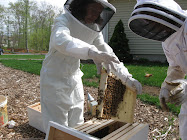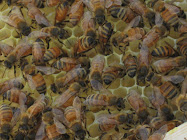I feel like I'm walking on egg shells. I am waiting for 'the other shoe to drop'. I am giddy with excitement when I look at my thriving strawberry plants (thanks to our handy dandy fence that's keeping the rabbits out!), but I am petrified that something is going to come along and ruin everything before they are ready! I am having pest stress!

Just last night I was examining my fruit trees and found that some of them have been anialated by a small green caterpillar. I tried picking them all off one by one and smashing them to smithereens. But, they were everywhere. Nearly all of the leaves had been destroyed, overnight. Finally I broke down and used an organic BT spray, which is a bacterium that disagrees with soft bodied bugs, on the trees whose flowers had already fallen off (kind of like the milky spore concept that's used for Japanese beetles). I didn't spray anything on those trees that had flowers because there is some talk that the BT bacterium may harm the larvae of the honey bee -- as the bees go right to the flower, take in the pollen and nectar, then feed it to their young -- which is at one point, larvae.

So of course I haven't sprayed my darling strawberry plants. But they are starting to show evidence that some bug or other is going after them. Argh! Garden Stress! They look so wonderful. So cheerful. So hopeful. I even saw one of my honey bees examining them yesterday. (Granted, one -- but hey! We are getting somewhere!)

My mantra this year is THIN THIN THIN. The sign of a novice gardener is someone who doesn't thin their seedlings. I fall into this category. I find it so difficult to pull out or cut down a cute little seedling filled with promise! This exposes my naivete. Although you might think that you will get more 'fruit' with more plants, if the plants are crowded the opposite is actually true. In addition the plants become stressed and more susceptible to disease. Drat. So now I have been thinning and thinning and thinning.

I've known this since I was a child and witnessed my father pulling out 'perfectly good' radish seedlings from the ground. "WHAT are you Dooooooing??!!" I said. "Thinning" he responded. It just seemed so wrong.

Here are my peas. (top and bottom) Two rows side by side 4 inches apart with a trellis in between. Last year my peas were attacked by deer and rabbits. We will see if the peas have better luck this year!

Here are my broccoli and cauliflower transplanted seedlings.

And some lovely lettuce that had been growing in my cold frames -- now exposed. It is pretty exciting to have lettuce ready for picking in early May (here in New England, that's exciting!)

Yum.

And my carrots. Another thing that suffered greatly last year because of Peter Rabbit.

I've been a good girl and have been thinning them out as need be.

One small potato sprout. Kristi and I are trying a new fangled potato tower made with wire fencing. Inside I've piled leaves, straw, grass clippings, compost and a little dirt. As the sprouts get taller, you cover up the stems with more of the 'compost cocktail' and repeat until you are at the top of the tower. Supposedly this will create a mountain of spuds within each tower. I am a little concerned about possible light exposure to the potatoes growing inside (on the edges) of the towers. Growing potatoes don't like light, and can 'green'. Time will tell. I'll keep you posted! (My Portuguese husband does not seem impressed.)
















































